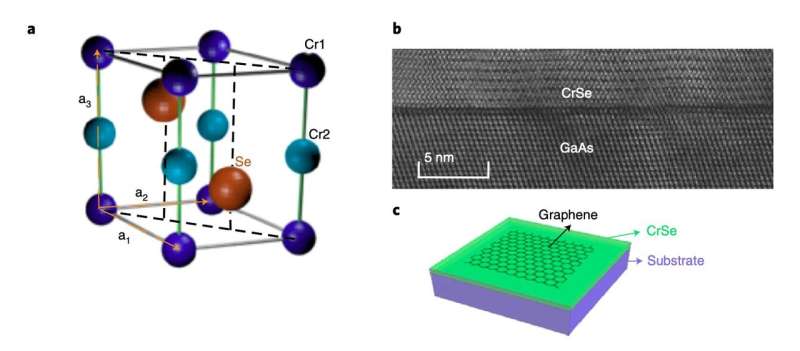September 10, 2020 feature
Large exchange splitting in monolayer graphene coupled to an antiferromagnet

Spintronics (or spin transport electronics) is a fairly new research field specialized in the development of devices that use the spin of electrons to store and process information. These devices could be a favorable alternative to traditional electronics, as they do not work using electric current and could thus prevent the implications of Joule heating. Joule heating is an effect that occurs in conventional electronic devices when current passing through a material produces thermal energy, consequently increasing the material's temperature.
Past studies have found that nonlocal spin currents can travel distances of 2 μm to 90 μm in graphene, which means that it could be an ideal material for fabricating spintronic devices. However, as graphene is not inherently spin-polarized, to use it in spintronic devices, researchers first need to devise strategies that allow it to transport spins.
This can be achieved by generating spin splitting in the material's band structure. One way to achieve spin splitting in graphene is by placing it close to magnetic materials, such as ferromagnets, ferrimagnets or antiferromagnets.
Researchers at University of California-Los Angeles, the National Institute of Standards and Technology, University of Tennessee and Beijing University of Technology have recently achieved significant exchange splitting in monolayer graphene by integrating it with an antiferromagnetic material. The strategy they used, presented in a paper published in Nature Electronics, could enable the use of graphene for fabricating highly performing, multifunctional spintronic devices.
"We show that monolayer graphene can be magnetized by coupling it to an antiferromagnetic thin film of chromium selenide (CrSe), resulting in an exchange splitting energy as high as 134 meV at 2K," the researchers wrote in their paper. "This exchange splitting is shown through shifts in the quantum Hall plateau and quantum oscillations in the graphene, and its energy can be modulated through field cooling, with the exchange splitting energy increasing with a positive field cooling and decreasing with negative field cooling."
The researchers mechanically exfoliated monolayer graphene onto a SiO2/Si substrate and then transferred it on top of a CrSe film. After they did this, they observed that the material presented a series of quantum oscillations that could be modulated using a technique known as field cooling. This suggests the occurrence of a sizeable spin splitting in the combined structure's graphene layer.
The measurements and results suggest that combining graphene with an antiferromagnetic material, such as CrSe, can enable large exchange splitting in the material. The average exchange splitting energy of the graphene/CrSe heterostructure outlined in the recent Nature Electronics paper is of ~134 meV. Interestingly, the researchers also found that the modulation of the graphene spectrum in this structure can be controlled.
Overall, these findings highlight the potential of this structure and potentially of other graphene/antiferromagnet structures for the development of spintronic devices with low dissipation and capable of long-distance spin transport. In addition to enabling the development of new spintronic devices, the structure created by the researchers could be used as a platform to study quantum interface mechanisms and dynamics. Future studies could also explore the potential of systems or structures in which graphene is coupled to other antiferromagnets with different crystal symmetries or properties.
More information: Large exchange splitting in monolayer graphene magnetized by an antiferromagnet. Nature Electronics (2020). DOI: 10.1038/s41928-020-0458-0.
© 2020 Science X Network


















